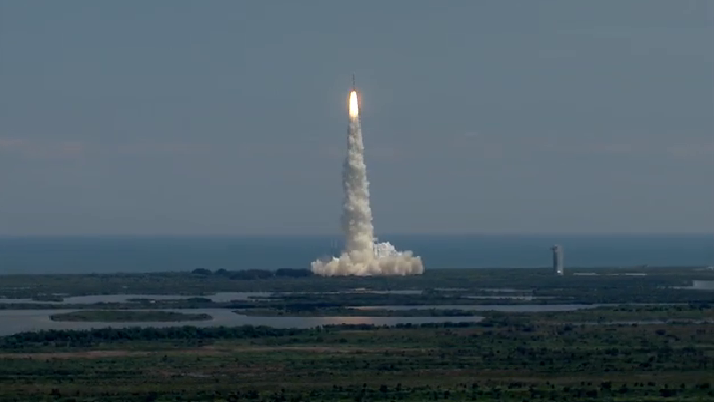Progress M-21M during docking test.
I have to admit, the look of a Russian spacecraft is growing on me. Although very cramped for space travelers, and certainly with this design "form meets function," the graceful maneuvering of a spacecraft with its parallel solar panels looking like a pair of wings is pretty cool. On Friday cosmonauts onboard the International Space Station redocked the robotic-controlled Progress M-12M spacecraft to the Russian module. Also designated Progress 53, the Russian craft had docked with the ISS back in November, bringing up needed supplies and equipment. The spacecraft sported the new KURS-NA automated docking systems, which allows for an easier r robotically controlled approach and docking. About 60 feet away from the station, the system suddenly suffered a glitch and required Oleg Kotov to use the station arm to grapple the craft and dock it manually. DUring this test, the craft undocked on April 23 just ahead of a planned EVA by American astronauts. The cosmonauts carefully ran the craft with help from ground engineers, testing maneuverability and robotic procedures. On April 25th, the tests were declared complete and the Progress redocked to the ISS. Ground engineers will spend the next couple of days studying the flight data.
SpaceX Dragon spacecraft docked to the Harmony module. Picture taken during the recent EVA.
Basically the Dragon resupply craft has a similar configuration to the Russian one, that is, with extended "wing" solar panels, a service module, and a cargo capsule. It does not have a disposable science module. The front science module on the Russian spacecraft is left over from the manned Soyuz capsule design, and in the case of a Progress mission, used for carrying more cargo. The true difference between the two designs, is that the Russian craft gets filled with waste and is then is "disposed of" by undocking it and letting it burn up during re-entry over the ocean. The Dragon capsule gets filled with items needed back on Earth, separates from the service module and is returned safely by parachute after de-orbiting.
Astronaut Steve Swanson during last week's EVA, replacing a vital computer backup system.
During the EVA last week, astronauts successfully replaced a backup computer system that would control the orientation of the solar panels of the ISS. In a short couple of hours, the astronauts again made the spacewalk look easy, despite the always-dangerous environment of outer space.
Update: From the April 20th docking of the SpaceX Dragon. Japanese astronaut and Expedition 39 commander Koichi Wakata (in blue) and NASA Flight Engineer Rick Mastracchio use the controls of the ISS robotic arm to grapple the Dragon once it moved into position near the station. NASA publishes the best of their activity photos within a few days after the event, so I get to "revisit" the event if I want to link to the improved images. As usual, uncredited photos on this blog are usually from NASA itself.
What's next for ISS? Of course every day brings astronaut activity inside the station, maintaining equipment, exercising to fight the effects of weightlessness, performing experiments and preparing for special events. The Progress 53 spacecraft will stay at the station until June 9. On May 29 Tuesday, it's thrusters will be used to orient the station for an upcoming May 13 undocking of the Soyuz TMA-11M which will carry Mikhail Tyurin, Koichi Wakata, and Rick Mastracchio back to Earth, edning Expedition 39. COming to replace them will be Expedition 40/41 crewmembers Max Suraev, Reid Wiseman, and Alexander Gerst, who will blast off from Kazakhstan on May 28.




































-Gemini.jpg)














